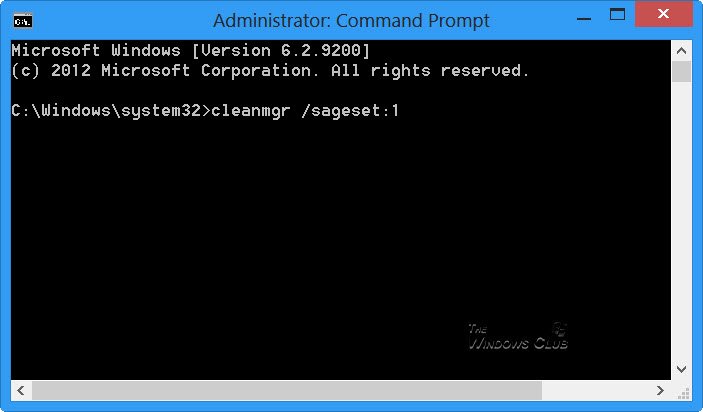In this tutorial, we will see how to activate some additional cleaning options and automate the cleanup operation, so that you don’t need to run the Disk Cleanup Utility or Cleanmgr.exe in Windows 11/10/8/7 manually, every time. We will see how to use the Command line version of Disk Cleanup Tool or Cleanmgr.exe with more cleaning options. Use Task Scheduler to run it automatically using sageset and sagerun arguments.
Command-line version of Disk Cleanup Utility or Cleanmgr.exe
To begin, open an elevated command prompt, type cleanmgr /sageset:n – where n can be any integer between 1 and 255.
This switch /sageset displays the Disk Cleanup Settings dialog box and creates a registry key to store the settings. The number denotes the settings which will be stored in the Registry when your run sagerun switch later on – and basically lets you make shortcuts to different stored configurations or schedule automatic cleanup in the Task Scheduler. In effect the /sagerun:n switch will run the specified tasks that are assigned to the n value by using the /sageset switch. Let’s begin with executing the following command: This will open the Command Line version of Disk Cleanup Utility offering many more cleanup options. If you have noticed, these are the options available in Cleanmgr.exe when you run it manually.
When you open it using sageset, as mentioned above, you will see the following clean-up options.
Command-line version of Disk Cleanup offers more cleaning options
The options offered may vary depending on your system, however.
You may be surprised to see so many options being available and wonder why Microsoft chose not to make accessing them easier! The options being offered may include:
Temporary setup filesDownloaded program filesTemporary internet filesOffline web pagesBranchCacheDebug dump filesOld chkdsk filesPrevious Windows installationsRecycle binUpdate package backup filesSetup log filesSystem error memory dump filesTemporary filesWindows Update CleanupFiles discarded by Windows upgradeUser file historyWindows DefenderPer user archived Windows error reporting filesPer-user queued Windows error reporting filesSystem archived Windows error reporting filesSystem queued Windows error reporting filesWindows ESD installation filesWindows upgrade log filesEtc.
Select the ones you want and click OK to save them. After you click OK, the settings (selection) will be stored in the Registry for future use. When you schedule it using cleanmgr /sagerun:1 to run through the Task Scheduler, it will take these settings for Disk Cleanup. If you want to run this “Enhanced” Disk Cleanup Utility right away, type cleanmgr /sagerun:1 in the cmd window and hit Enter. Alternatively, you could type C:\Windows\system32\cleanmgr.exe /sagerun:1 in a Run window and hit Enter. The disk cleanup operation will start right away.
TIP: To start the Disk Cleanup Tool with all the options pre-selected, use the /lowdisk switch. That is, open Run box and type the following and hit Enter: cleanmgr /lowdisk
Schedule and Automate running of Disk Cleanup Utility
If you would like to schedule Disk Cleanup Utility to run automatically, every once in a while, you can do so using the Task Scheduler. To do so, open Task Scheduler from the Control Panel. This post on How to Schedule a Task in Windows will give you more details about it. Click on Create Basic Task. Give it a name and description.
Select the Trigger; in this case the frequency. Click Next.
Since we have selected Monthly, fill in the other required details, and click Next.
As Action, select Start a program and click Next.
Since we want to run the Disk Cleanup Utility, write C:\Windows\system32\cleanmgr.exe and Add argument as /sagerun:1. As we have saved the disk cleanup setting using the number ‘1’, we are using the same number ‘1’ here. Click Next.
Check the Summary. Select the Open Properties box and click Finish.
The Monthly Disk Cleanup Properties box will open where you will get to see details like Triggers, History, General Settings, Actions, and Conditions.
That’s it! The Disk Cleanup Utility – with the additional options set – will run every month to keep your disk clean.

